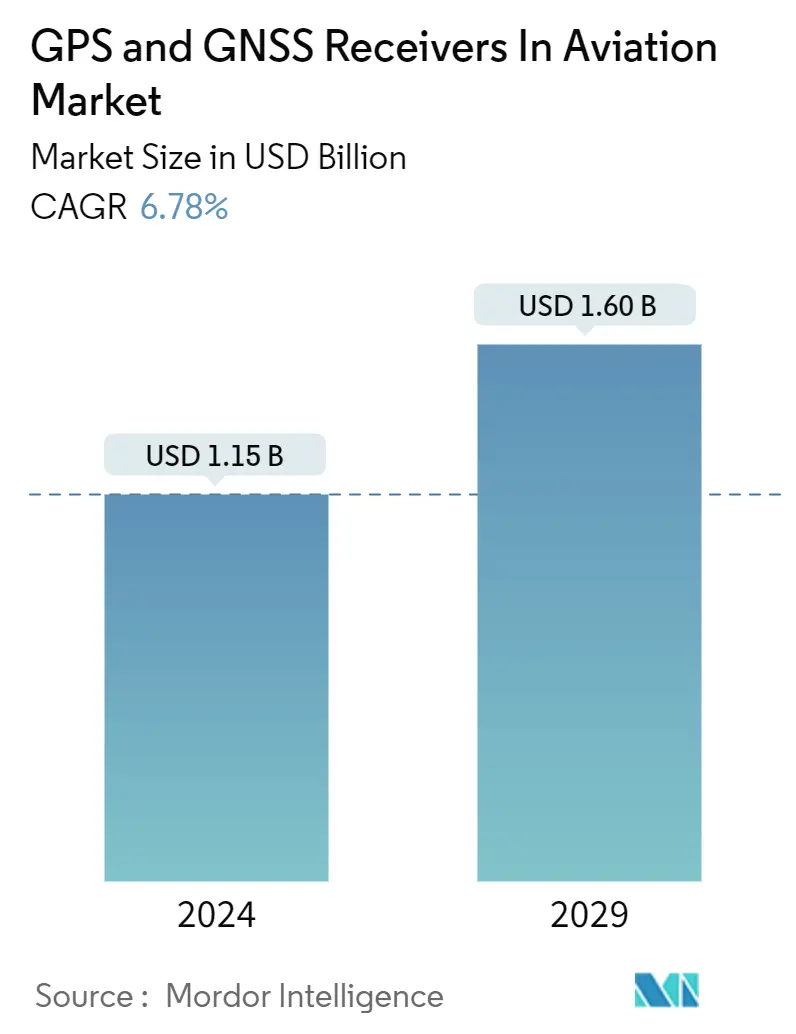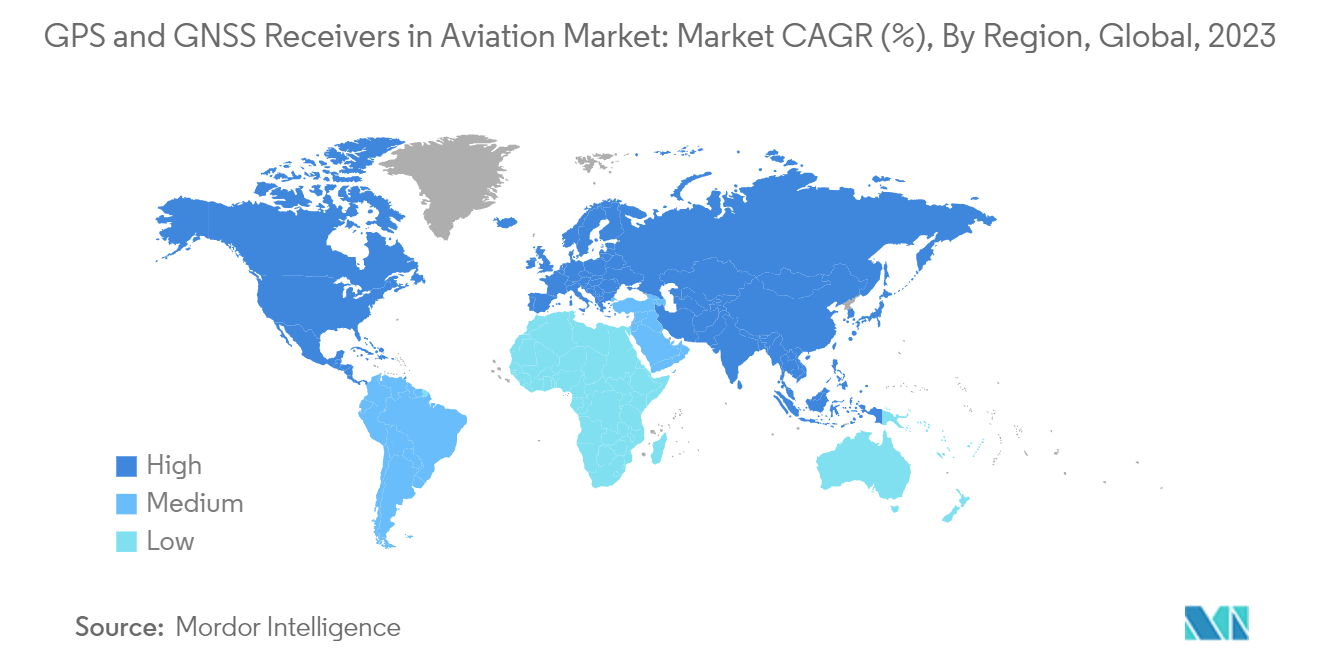
| Study Period | 2019 - 2029 |
| Market Size (2024) | USD 1.15 Billion |
| Market Size (2029) | USD 1.60 Billion |
| CAGR (2024 - 2029) | 6.78 % |
| Fastest Growing Market | Asia-Pacific |
| Largest Market | Asia-Pacific |
| Market Concentration | Medium |
Major Players
*Disclaimer: Major Players sorted in no particular order |
GPS And GNSS Receivers In Aviation Market Analysis
The GPS And GNSS Receivers In Aviation Market size is estimated at USD 1.15 billion in 2024, and is expected to reach USD 1.60 billion by 2029, growing at a CAGR of 6.78% during the forecast period (2024-2029).
- The global positioning system (GPS) and global navigation satellite system (GNSS) receivers in the aviation market witnessed unprecedented challenges due to the COVID-19 pandemic. The demand for commercial and military aircraft slumped due to low economic growth, a decrease in air traffic passengers, and a decline in aviation operations.
- Moreover, there had been a decrease in the growth rate of wide-body aircraft and narrow-body aircraft orders owing to the grounding of the Boeing 737 MAX aircraft. Nevertheless, the slump was temporary, and the market was anticipated to witness robust growth due to the demand for such equipment both from aircraft original equipment manufacturers (OEMs) and maintenance, repair, and overhaul (MRO) service providers.
- Most of the GPS equipment designed for use in commercial aircraft is permanently installed in tested and approved locations with appropriate power supplies and is integrated with other flight systems. Air navigation systems usually have a moving map display and are often connected to the autopilot for en-route navigation. With the growth of the aviation industry and the introduction of new aircraft to the fleet, the demand for quick and hassle-free aircraft navigation will boost the demand for GPS and GNSS Receivers in the Aviation market during the forecast period.
GPS And GNSS Receivers In Aviation Market Trends
Military Aviation Segment is Anticipated to Grow with the Highest CAGR During the Forecast Period
- The military aviation segment is expected to show significant growth during the forecast period. The growth can be attributed to the increasing military expenditure by governments of all regions, rising demand for new military aircraft, and growing military modernization programs. Satellite navigation is very crucial for carrying out military missions for navigation purposes in enemy territories and is especially important in the absence of light in night missions. The military forces heavily rely on GNSS and GPS in order to obtain an accurate positioning of their own units, as well as the enemy force's positions.
- Several defense bodies also depend on GPS and GNSS technologies as it helps the forces to efficiently conduct their missions. The United States, China, India, the UK, Russia, and France are currently the world's largest military spenders, respectively. In August 2021, BAE Systems plc unveiled its ultra-small MicroGRAM-M global positioning system receiver compatible with next-generation M-Code military GPS that is resistant to jamming and spoofing. MicroGRAM-M is the world's smallest, lightest, and most power-efficient GPS receiver for size-constrained and other micro-applications.
- Countries are increasing their military budgets in order to modernize their military aircraft fleet. With the rise in military aircraft, the demand for GPS and GNSS receivers will also increase during the forecast period.

Asia Pacific Will Showcase Remarkable Growth During the Forecast Period
- Asia-Pacific is projected to show the highest growth during the forecast period. Growing expenditure on the aviation sector and growing demand for new aircraft, especially from China and India, boost the market growth across the region. According to the International Air Transport Association (IATA), China surpassed the United States and became the largest aviation market in the world in 2022. Furthermore, China is expected to reach a total of 1.5 billion aviation passengers by 2036.
- Also, the Indian civil aviation ministry announced that India would become the third-largest domestic aviation market in 2021. Furthermore, the procurement of next-generation fighter jets from India, China, and Japan will propel the growth of the market. As the aircraft fleet commercial and military increases, the demand for navigation devices, particularly GPS and GNSS, will also increase, leading to the growth of the market.
- For instance, in December 2021, Russian space agency Roscosmos and the Chinese Satellite Navigation System Commission signed an agreement for the development of navigation systems, Russia's GLONASS and China's BeiDou, and installing ground-based measuring sites on the territory of both states. Thus, the growing demand for commercial and military aircraft from Asian countries drives the growth of the market.

GPS And GNSS Receivers In Aviation Industry Overview
The GPS and GNSS receivers in the aviation market are semi-consolidated in nature, with few players holding significant shares in the market. Some prominent market players are Cobham Limited, Trimble Inc., Qualcomm Technologies, Inc., L3Harris Technologies, Inc., and Topcon Positioning Systems, Inc. These major players operating in this market have adopted various strategies comprising mergers and acquisitions, investment in R&D, collaborations, partnerships, regional business expansion, and new product launches.
For instance, in November 2020, Cobham Aerospace Connectivity was selected by the General Atomics Aeronautical Systems, Inc. (GA-ASI) and the U.S. Army to provide the anti-jam GPS systems for the MQ-1C ER Gray Eagle Extended Range (GE-ER) Unmanned Aircraft System (UAS) platform. In addition, L3 Harris is building the next-generation GPS III satellite constellation by developing and integrating advanced navigation and timing payload technologies.
GPS And GNSS Receivers In Aviation Market Leaders
-
Cobham Limited
-
Trimble, Inc.
-
Qualcomm Technologies, Inc.
-
Topcon Positioning Systems, Inc.
-
L3Harris Technologies, Inc.
- *Disclaimer: Major Players sorted in no particular order

GPS And GNSS Receivers In Aviation Market News
June 2023: Flare Bright, a UK-based company, launched its new inertial navigation system (INS) enhancement device integrated with machine-earning software to enhance the accuracy of the INS. The US Department of Defense, the UK Ministry of Defence, and some major defense primes are current customers for the company's INS.
August 2021: Honeywell and InfiniDome collaborated on the development and delivery of GPS signal protection systems for various vehicles, including commercial and military aircraft, urban air mobility (UAM) platforms, unmanned aircraft systems (UAS), and surface vehicles.
August 2021: Topcon was awarded a contract by DDK Positioning Ltd. to supply hardware components for the global navigation satellite system (GNSS).
GPS And GNSS Receivers In Aviation Industry Segmentation
GNSS refers to the Global Navigation Satellite System, a global satellite system that transmits signals for navigation. GPS stands for Global Positioning System, an application of GNSS widely used to track aircraft positioning in the aviation industry.
The GPS and GNSS receivers in the aviation market are segmented by end-user and type. By end-use, the market is segmented into commercial aviation and military aviation. By type, the market is segmented into wired receivers and wireless receivers. The report also covers the market sizes and forecasts for the GPS and GNSS Receivers in aviation market in major countries across different regions. For each segment, the market size is provided in terms of value (USD).
| End-Use | Commercial Aviation | |
| Military Aviation | ||
| Type | Wired Receivers | |
| Wireless Receivers | ||
| Geography | North America | United States |
| Canada | ||
| Geography | Europe | United Kingdom |
| Germany | ||
| France | ||
| Russia | ||
| Rest of Europe | ||
| Geography | Asia Pacific | China |
| India | ||
| Japan | ||
| South Korea | ||
| Rest of Asia Pacific | ||
| Geography | Latin America | Brazil |
| Rest of Latin America | ||
| Geography | Middle East and Africa | Saudi Arabia |
| United Arab Emirates | ||
| South Africa | ||
| Rest of Middle East and Africa |
GPS And GNSS Receivers In Aviation Market Research Faqs
How big is the GPS And GNSS Receivers In Aviation Market?
The GPS And GNSS Receivers In Aviation Market size is expected to reach USD 1.15 billion in 2024 and grow at a CAGR of 6.78% to reach USD 1.60 billion by 2029.
What is the current GPS And GNSS Receivers In Aviation Market size?
In 2024, the GPS And GNSS Receivers In Aviation Market size is expected to reach USD 1.15 billion.
Who are the key players in GPS And GNSS Receivers In Aviation Market?
Cobham Limited, Trimble, Inc., Qualcomm Technologies, Inc., Topcon Positioning Systems, Inc. and L3Harris Technologies, Inc. are the major companies operating in the GPS And GNSS Receivers In Aviation Market.
Which is the fastest growing region in GPS And GNSS Receivers In Aviation Market?
Asia-Pacific is estimated to grow at the highest CAGR over the forecast period (2024-2029).
Which region has the biggest share in GPS And GNSS Receivers In Aviation Market?
In 2024, the Asia-Pacific accounts for the largest market share in GPS And GNSS Receivers In Aviation Market.
What years does this GPS And GNSS Receivers In Aviation Market cover, and what was the market size in 2023?
In 2023, the GPS And GNSS Receivers In Aviation Market size was estimated at USD 1.07 billion. The report covers the GPS And GNSS Receivers In Aviation Market historical market size for years: 2019, 2020, 2021, 2022 and 2023. The report also forecasts the GPS And GNSS Receivers In Aviation Market size for years: 2024, 2025, 2026, 2027, 2028 and 2029.
Our Best Selling Reports
GPS And GNSS Receivers In Aviation Industry Report
Statistics for the 2024 GPS And GNSS Receivers In Aviation market share, size and revenue growth rate, created by Mordor Intelligence™ Industry Reports. GPS And GNSS Receivers In Aviation analysis includes a market forecast outlook to for 2024 to (2024to2029) and historical overview. Get a sample of this industry analysis as a free report PDF download.




